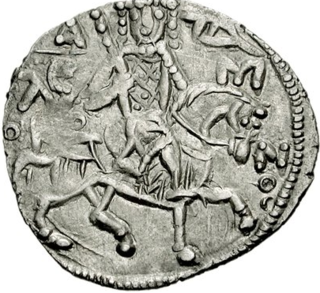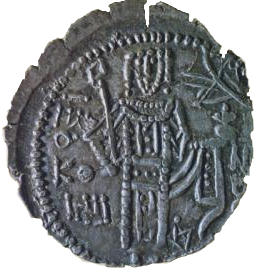Related Research Articles

Alexios I Komnenos, Latinized Alexius I Comnenus, was Byzantine emperor from 1081 to 1118. Although he was not the first emperor of the Komnenian dynasty, it was during his reign that the Komnenos family came to full power and initiated a hereditary succession to the throne. Inheriting a collapsing empire and faced with constant warfare during his reign against both the Seljuq Turks in Asia Minor and the Normans in the western Balkans, Alexios was able to curb the Byzantine decline and begin the military, financial, and territorial recovery known as the Komnenian restoration. His appeals to Western Europe for help against the Turks was the catalyst that sparked the First Crusade.

Andronikos I Komnenos, Latinized as Andronicus I Comnenus, was Byzantine emperor from 1183 to 1185. He was the son of Isaac Komnenos and the grandson of the emperor Alexios I. In later Byzantine historiography, Andronikos I became known under the epithet "Misophaes" in reference to the great number of enemies he had blinded.

Theodore I Laskaris or Lascaris was the first emperor of Nicaea—a successor state of the Byzantine Empire—from 1205 to his death. Although he was born to an obscure aristocratic family, his mother was related to the imperial Komnenos clan. He married Anna, a younger daughter of Emperor Alexios III Angelos in 1200. He received the title of despot before 1203, demonstrating his right to succeed his father-in-law on the throne.
David Megas Komnenos was the last Emperor of Trebizond from 1460 to 1461. He was the third son of Emperor Alexios IV of Trebizond and Theodora Kantakouzene. Following the fall of Trebizond to the Ottoman Empire, he was taken captive with his family to the Ottoman capital, Constantinople, where he and his sons and nephew were executed in 1463.

The Empire of Trebizond, or Trapezuntine Empire, was a monarchy and one of three successor rump states of the Byzantine Empire, along with the Despotate of the Morea and the Principality of Theodoro, that flourished during the 13th through to the 15th century, consisting of the far northeastern corner of Anatolia and portions of southern Crimea. The empire was formed in 1204 with the help of the Georgian queen Tamar after the Georgian expedition in Chaldia and Paphlagonia, commanded by Alexios Komnenos a few weeks before the sack of Constantinople. Alexios later declared himself Emperor and established himself in Trebizond. Alexios and David Komnenos, grandsons and last male descendants of deposed Emperor Andronikos I Komnenos, pressed their claims as "Roman emperors" against Byzantine Emperor Alexios V Doukas. The later Byzantine emperors, as well as Byzantine authors, such as George Pachymeres, Nicephorus Gregoras and to some extent Trapezuntines such as John Lazaropoulos and Basilios Bessarion, regarded the emperors of Trebizond as the "princes of the Lazes", while the possession of these "princes" was also called Lazica. Thus from the point of view of the Byzantine writers connected with the Laskaris and later with the Palaiologos dynasties, the rulers of Trebizond were not emperors.
The House of Komnenos, Latinized as Comnenus, was a Byzantine Greek noble family who ruled the Byzantine Empire in the 11th and 12th centuries. The first reigning member, Isaac I Komnenos, ruled from 1057 to 1059. The family returned to power under Alexios I Komnenos in 1081 who established their rule for the following 104 years until it ended with Andronikos I Komnenos in 1185. In the 13th century, they founded and ruled the Empire of Trebizond, a Byzantine rump state from 1204 to 1461. At that time, they were commonly referred to as Grand Komnenoi, a style that was officially adopted and used by George Komnenos and his successors. Through intermarriages with other noble families, notably the Doukas, Angelos, and Palaiologos, the Komnenos name appears among most of the major noble houses of the late Byzantine world.

Manuel III Megas Komnenos was Emperor of Trebizond from 20 March, 1390 to his death in 1417.
Michael Panaretos was an official of the Trapezuntine empire and a Greek historian. His sole surviving work is a chronicle of the Trapezuntine empire of Alexios I Komnenos and his successors. This chronicle not only provides a chronological framework for this medieval empire, it also contains much valuable material on the early history of the Ottoman Turks from a Byzantine perspective, however it was almost unknown until Jakob Philipp Fallmerayer discovered it in the nineteenth century among the manuscripts of the Biblioteca Marciana of Venice. "Owing to this drab but truthful chronicle," writes the Russian Byzantist Alexander Alexandrovich Vasiliev, "it has become possible to a certain extent to restore the chronological sequence of the most important events in the history of Trebizond. This Chronicle covers the period from 1204 to 1426 and gives several names of emperors formerly unknown."
Andronikos II Megas Komnenos, or Andronicus II Grand Comnenus, was the Emperor of Trebizond from 1263 to 1266. Despite being the designated successor of his father Manuel I, Andronikos' tenure was short due to premature death from unrecorded causes. The major event of his reign was the definitive loss of Sinope to the Seljuk Turks under the regency of Mu'in al-Din Suleyman, also known as the Pervane, in the summer or fall of 1265. The capture of Sinope by the Turks gave them the best port on the Black Sea, allowing them to create a navy and compete with the Trapezuntines for influence in the Black Sea.
Alexios I Megas Komnenos or Alexius I Megas Comnenus was, with his brother David, the founder of the Empire of Trebizond and its ruler from 1204 until his death in 1222. The two brothers were the only male descendants of the Byzantine Emperor Andronikos I, who had been dethroned and killed in 1185, and thus claimed to represent the legitimate government of the Empire following the conquest of Constantinople by the Fourth Crusade in 1204. Although his rivals governing the Nicaean Empire succeeded in becoming the de facto successors, and rendered his dynastic claims to the imperial throne moot, Alexios' descendants continued to emphasize both their heritage and connection to the Komnenian dynasty by later referring to themselves as Megas Komnenos.

The AIMA prophecy was a prophecy current during the reign of the Byzantine emperor, Manuel I Komnenos and at the same time an example of a medieval contrived acronym.

Alexios II Megas Komnenos, was Emperor of Trebizond from 1297 to 1330. He was the elder son of John II and Eudokia Palaiologina.
Anna Anachoutlou ruled the Empire of Trebizond from 1341 to 1342. She was the eldest daughter of the Trapezuntine emperor Alexios II Megas Komnenos and had joined a convent as a nun during her father's reign. After the death of her father, Anna's brother Andronikos III, her nephew Manuel II and her other brother Basil reigned in rapid succession. After Basil's death, his widow Irene Palaiologina, genealogically unconnected to the ruling Grand Komnenos dynasty of Trebizond, seized power as empress regnant. In June/July 1341, Anna escaped from her convent and rapidly began rallying support to fight against Irene. Despite being a woman and up until recently a nun, and there being several possible male heirs of her dynasty, Anna attracted considerable support from the provincials of the empire, from ethnic minorities such as the Laz and Zan peoples, and from Georgian soldiers, either mercenaries or forces sent by King George V of Georgia.

Michael Megas Komnenos was Emperor of Trebizond from 3 May 1344 to 13 December 1349. He was a younger son of Emperor John II of Trebizond and Eudokia Palaiologina.

The House of Laskaris or Lascaris was a Byzantine Greek noble family which rose to prominance during the Late Byzantine period. The members of the family formed the ruling dynasty of the Empire of Nicaea, a Byzantine rump state that existed from the 1204 sack of Constantinople by the Fourth Crusade until the restoration of the Empire under the Palaeologan dynasty in 1261.
The House of Angelos, Latinised as Angelus, was a Byzantine Greek noble family that produced several Emperors and other prominent nobles during the middle and late Byzantine Empire. The family rose to prominence through the marriage of its founder, Constantine Angelos, with Theodora Komnene, the youngest daughter of Emperor Alexios I Komnenos. As imperial relatives, the Angeloi held various high titles and military commands under Emperor Manuel I Komnenos. In 1185, following a revolt against Andronikos I Komnenos, Isaac II Angelos rose to the throne establishing the Angeloi as the new imperial family that ruled until 1204. The period was marked by the decline and fragmentation of the Byzantine Empire, culminating in its dissolution by the Fourth Crusade in 1204 under Alexios IV Angelos.

The mesazon was a high dignitary and official during the last centuries of the Byzantine Empire, who acted as the chief minister and principal aide of the Byzantine emperor.
Eudokia Megale Komnene, was a Trapezuntine princess and a member of the powerful Byzantine Komnenos dynasty as a daughter of Emperor Alexios III of Trebizond.
Gabras or Gavras feminine form Gabraina (Γάβραινα), is the name of an important Byzantine aristocratic family which became especially prominent in the late 11th and early 12th centuries as the semi-independent and quasi-hereditary rulers of Chaldia.
Since its fall, the issue of succession to the Byzantine Empire has been a major point of contention both geopolitically, with different states laying claim to its legacy and inheritance, and among the surviving members of the Byzantine nobility and their descendants. Historically, the most prominent claims have been those of the Ottoman Empire, which conquered Byzantium in 1453 and ruled from its former capital, Constantinople; the Russian Empire, as the most powerful state practising Eastern Orthodox Christianity; and various nobles and figures in Western Europe of increasingly spurious and questionable imperial descent.
References
- ↑ A. Bryer and D. Winfield, The Byzantine Monuments and Topography of the Pontos, pp.300
- ↑ N. Oikonomides, "The Chancery of the Grand Komnenoi: Imperial Tradition and Political Reality", Archeion Pontou, 35 (1979), pp. 312f
- ↑ L. G. Westerink, "La profession de foi de Grégoire Chioniadès", Revue des études byzantines, 38, (1980), pp. 235f
- ↑ Oikonomides, "The Chancery", pp. 322-324; Rosenqvist, J.O., "Three Trapezuntine Notes", Byzantinoslavica, 54 (1993), pp. 294-299